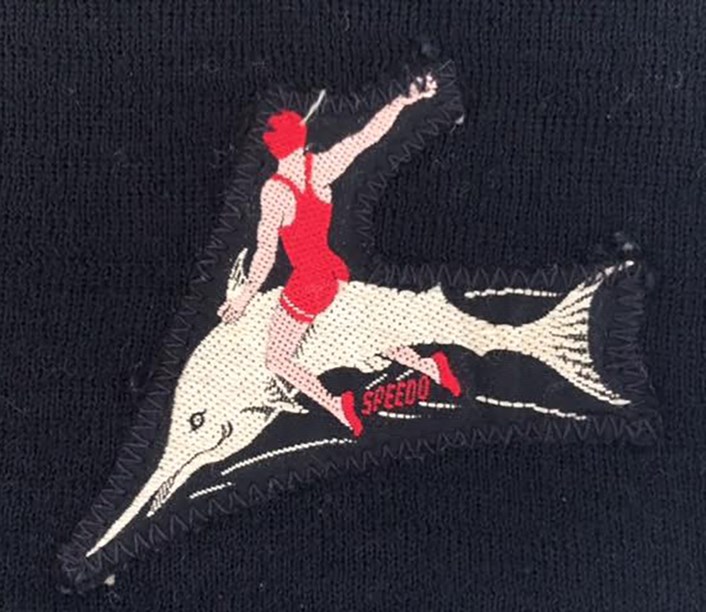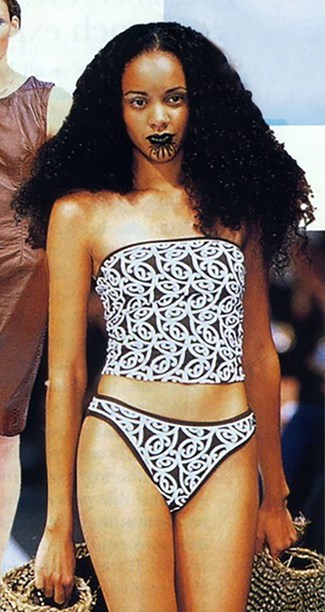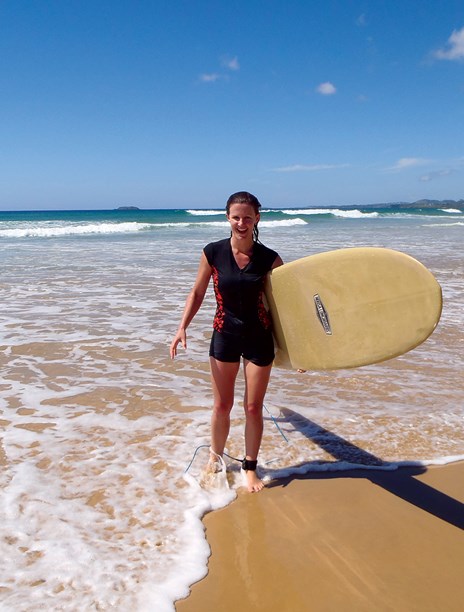Stories
Making Swimwear in New Zealand
1915-2015

The story of swimwear manufacturing in New Zealand starts with wool. It’s not a fabric we associate with swimming now, but our early woollen knitting mills such as Lane Walker Rudkin, Roslyn and Manawatu Knitting Mills made swimsuits for men and women for the first half of the 20th century.
Recognising the limited seasonal demand for woollen clothing, these companies sought to diversify and respond to changing social trends. One of the new trends was swimming, which was heralded in the first modern Olympic Games in 1896.

Women at work at the Manawatu Knitting Mills, circa 1925. Image courtesy of Ian Matheson City Archives.
Lane Walker Rudkin, the company behind the Canterbury brand, was established in 1904 and by 1910 it had produced its first knitted woollen swimsuits.

A 1930s advertisement for Canterbury swimsuits, made by Lane Walker Rudkin. Image supplied by Quentin Wilson.
The first exemplars for men looked like long john underwear and were produced in black to reveal as little as possible of what was underneath. For women, a knitted tunic and knee-length shorts known as the Canadian became popular. The technical and fashion demands of swimwear production ensured these companies kept up with the latest in materials and manufacturing technologies keeping up to the minute. Knitted wool was the material of choice until the 1940s when elastic fibres became more accessible.
For swimwear, branding was one of its significant features with logos embroidered or stitched to the outside of the garment. The cache of the label was an important part of the swimwear story as early as 1920, for example, the Jantzen 'diving girl' and their slogan 'The Suit That Changed Bathing to Swimming', Speedo with 'Speed on in your Speedos', the green fern of the Pacific brand by Canterbury and the Roslyn label with the swimmer on the back of a seagull.

Manawatu Knitting Mills manufactured Speedo swimwear under licence in the 1930s.
The demand for prestigious international brands was fulfilled by local companies making these swimsuits under licence. Garment manufacturers A J Coleman in Tawa acquired the license for Jantzen. Cole of California, worn by Esther Williams in her films, was made in Auckland by California Fashions Ltd. Holeproof Industries, which opened in Auckland in 1938, produced the sophisticated Rose Marie Reid label.

American label Jantzen - with its a sporty profile and a philosophy of flattering the female form - was made in New Zealand under licence.
Lane Walker Rudkin bought the licence for glamour label Mabs of Hollywood in 1947. It also acquired Catalina, the label associated with the Miss USA and Miss Universe pageants, and Speedo.
When swimwear fashion moved from 1950s Hollywood glamour to a youthful 1960s Californian surfer look, brands such as Jantzen and Catalina also included more activewear that was also made here.
In the 1970s and 1980s, local swimwear labels Expozay and Moontide successfully took New Zealand style to the world.
Expozay was started in Tauranga by Judy and Tony Alvos in 1976. The brand’s focus was on subtly sexy suits in vibrant colours and original prints. By 1978 they were selling into Australia, and a decade later the company had some 900 accounts throughout UK, Japan and North America including the major department stores.
Expozay swimsuits featured on the covers of Vogue, Dolly, Cleo and Sports Illustrated. In 1981 the company was honoured with a New Zealand Export Award.
Established in 1980 by Tony Hart, Moontide championed the beach-loving New Zealand lifestyle using stylised Māori motifs and South Pacific colours and imagery in their original textile prints.

Moontide's Australian Fashion Week show in 1998 featured garments printed with a Māori motif.
Moontide crossed the ditch in 1984, and by 1990 it was one of the top five swimwear labels in Australia; Expozay was another. In the UK Moontide was sold in Harvey Nichols and Harrods, which opened up the European market. British Underlines magazine named Moontide the best swimwear range in 1989 and 1990 and it won a Best Sportswear Award in the United Kingdom in 1998. The brand continues today, produced in China and sold in 50 countries.
In 1961 Dutch immigrant designer Frank Carpay, his wife Carla, and patternmaker Robert Leek developed a range of beachwear for men and women. Frank created his own Pacific-inspired designs which were printed on to towelling.
Boutique designers have also found loyal markets for their unique styles of swimwear. Jennifer Godward established her label Jennifer Dean in 1960. She sold her fashionable and funky bikinis in Vulcan Lane, Auckland, and wholesaled around the country. In 1990 the brand was sold and with manufacturing off shore it continues to be a success today.Lonely began as clothing label Lonely Hearts in 2003. It launched Lonely Lingerie in 2009 and it was a natural progression to add swimwear in 2014, following the signature long lines, straps and cut-outs seen in the lingerie.

Lonely's Edie bikini, 2014.
Designer Helene Morris produces two swimwear collections a year which are manufactured in China. Her partner Steve Ferguson manages Lonely’s hugely successful social media strategy, which has given @Lonelylingerie an Instagram following of over 300,000.

Covertogs makes suits that offer sun protection, comfort and support. Image courtesy of Covertogs.
A different niche is catered for by Covertogs, the brainchild of Karen Newton who saw a gap in the market for swimwear for women who don't feel comfortable in a regular bathing suit but still want to be active at the beach and in the water. With almost all swimwear manufacturing now having moved off shore, they consider themselves lucky to have located an ex-Moontide machinist with the skills and specialist knowledge to make their suits in New Zealand.
The culture of ease and functionality evident in our beach attire, is also apparent in the fashion that defines New Zealand style. The modesty and decorum so required at the beginning of the 1900s still chimes in contemporary New Zealand fashion with our penchant for layering, preferring to cover up rather than to strip away and expose the body.
We are not generally flamboyant or overly formal, we are sensible rather that frilly, feminine and embellished, we choose clothes that are pared back, understated and often black. Leisure, pleasure, activity and practicality are positive values associated with our beach culture and it is these qualities that are elevated to fashionable features by our contemporary designers.
Text by Doris de Pont. Banner image of towelling beachwear made by Frank Carpay, circa 1965.
Last published January 2016.